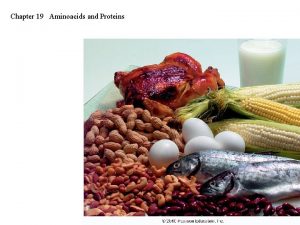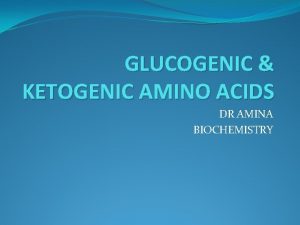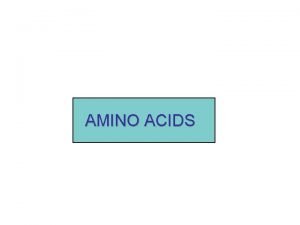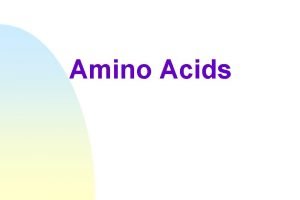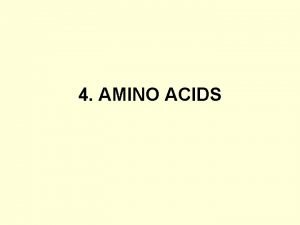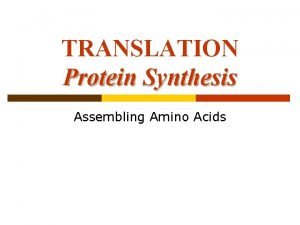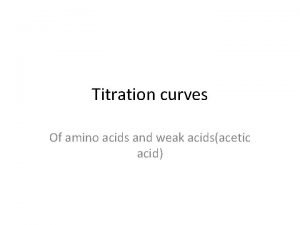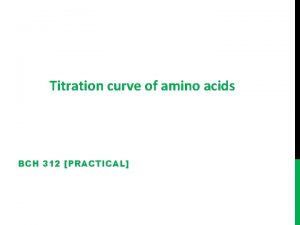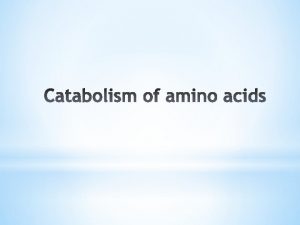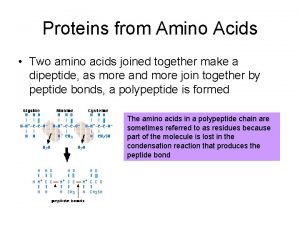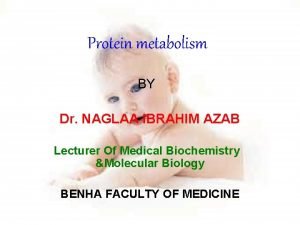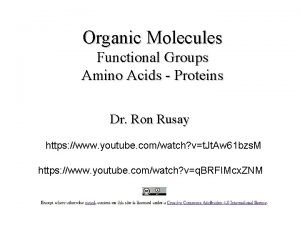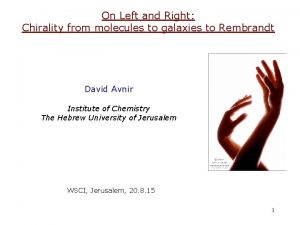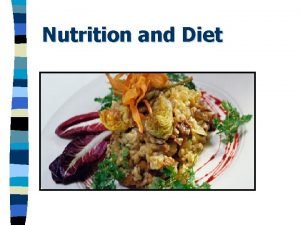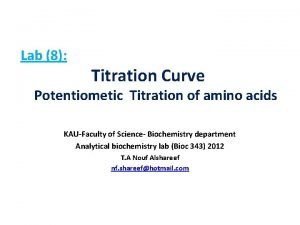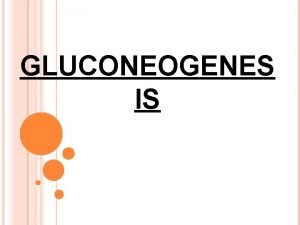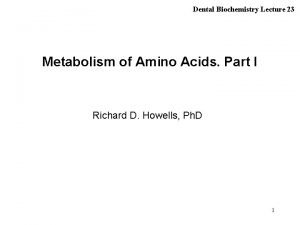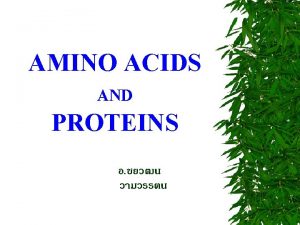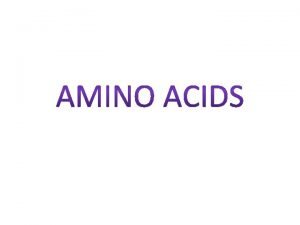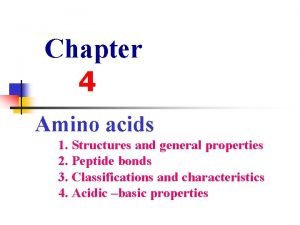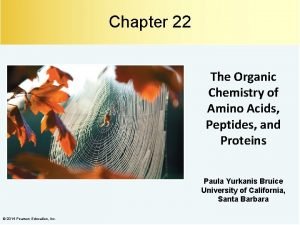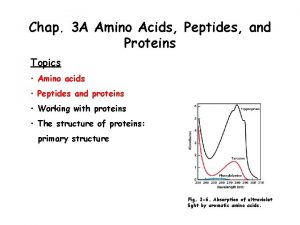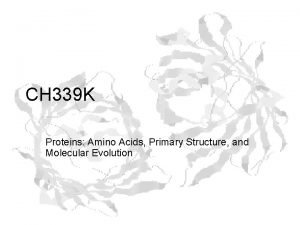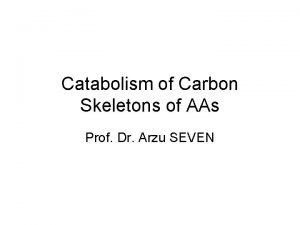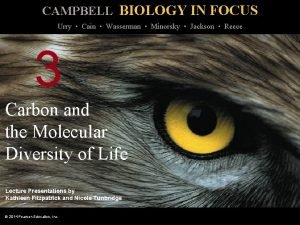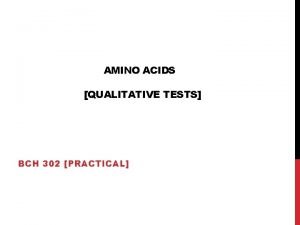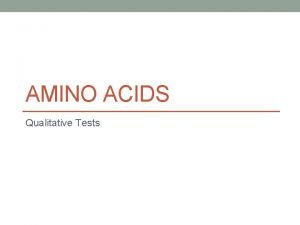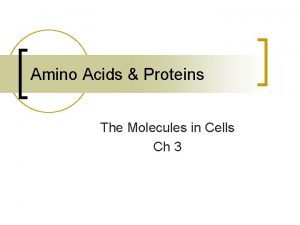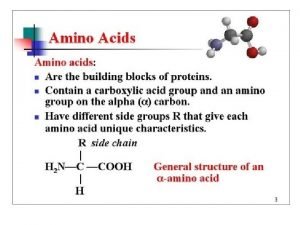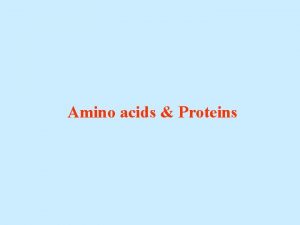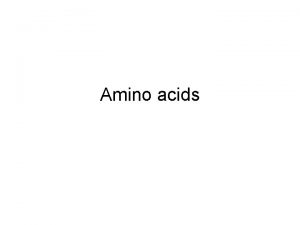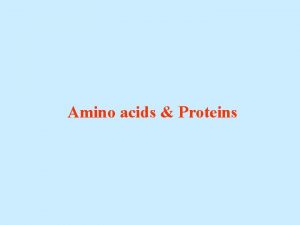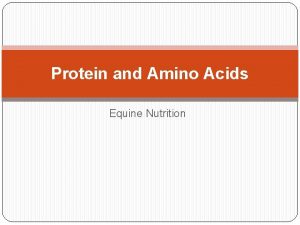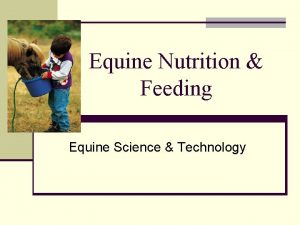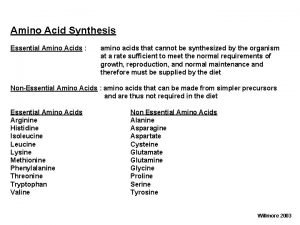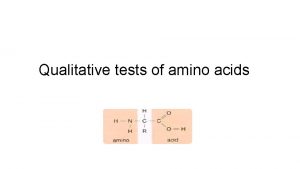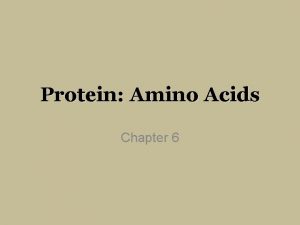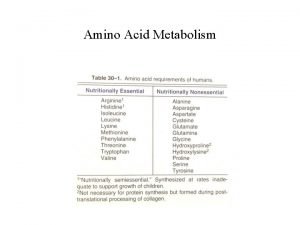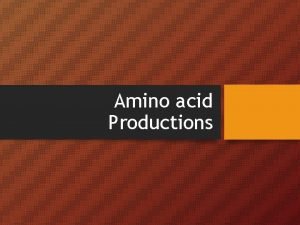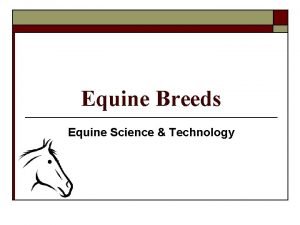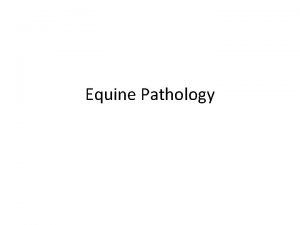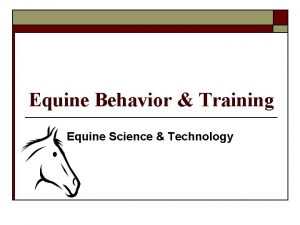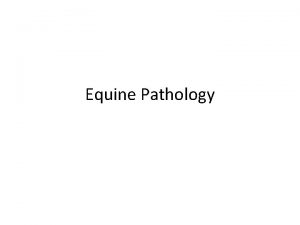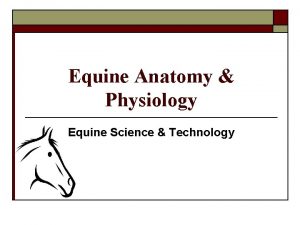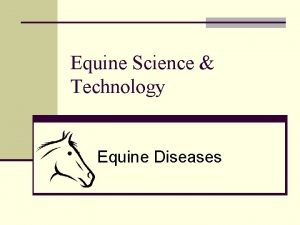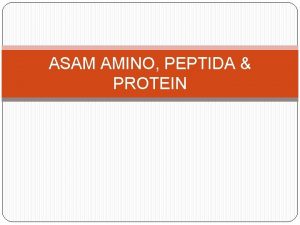Protein and Amino Acids Equine Nutrition Introduction Protein






























- Slides: 30

Protein and Amino Acids Equine Nutrition

Introduction �Protein is a major component of most body tissues including: �Muscle �Bone �Cartilage �Tendons and Ligaments �Hair and Hooves �Enzymes, hormones, and antibodies �What are proteins made up of? �Peptides �Amino acids

Introduction �What is an amino acid? �How many primary amino acids are important in most protein make-ups? � 20


Introduction �What differentiates one protein from another? �Types of amino acid incorporated into a protein chain �Length of protein chain �Horse’s requirement is actually for what? �Amino acids �What’s the difference between an essential and non-essential amino acid? �Essential cannot be synthesized in the body in sufficient quantities

Introduction � Do horses have essential amino acid requirements? Do ruminants? � � One – Lysine Two – Threonine Three - Methionine No � How many essential amino acids have been established for the non- ruminant? � PVT MAT HILL � � � � � Phenylalanine Valine Threonine Methonine Arginine Tryptophan Histidine Isoleusine Lysine

Introduction � What is a limiting amino acid? �All necessary amino acids required for a protein to be made must be present at the same time � A limiting amino acid is not present in adequate quantities when protein synthesis is taking place � This will limit protein synthesis � So what is the challenge when feeding horses protein? �Provide adequate quantities that will allow for sufficient concentrations of circulating amino acids in the blood �Important so that synthesis of � Tissues, enzymes, hormones, and tissue repair can take place when necessary

Protein Digestion and Utilization �Where is dietary protein mainly digested? �Stomach and small intestine �Enzymatic digestion occurs in the stomach via �Pepsin �Can break down specific amino acid bonds �Pancreatic proteases continue breakdown �Secreted into S. I. �Enable absorption of A. A. and di-peptides �Di-peptides are hydrolyzed into A. A. in gut wall �NPN are also absorbed in S. I.

Protein Digestion and Utilization � Some protein and NPN may escape foregut digestion �Enter into hindgut to produce � Does the horse produce microbial protein? � Yes, but: �Unlike the ruminant, no evidence that amino acids from microbial protein synthesis are absorbed in sufficient quantities to contribute to the A. A. pool � This suggests what? �Quality of protein is important in the horse’s diet �Amino acid profiles are important �While microbial amino acid synthesis occurs, it is not significant enough to provide for amino acid requirements

Protein Digestion and Utilization �Can you feed NPN to horses? �Yes, but not useful in most circumstances �Maybe useful when protein requirements are deficient �Generally considered little to no benefit to the horse �Is it toxic? �Only at extreme high levels

Protein Digestibility �What is protein quality? �A function of the amino acid profile �Digestibility of the protein source �The higher the digestibility (especially foregut) �The higher the absorption of amino acids �More contribution to the amino acid pool for tissue synthesis and repair

Protein Digestibility �How can we determine Protein digestibility? �Function of two things �DMI �CP concentration �As both go up, digestibility goes up

Protein Digestibility � Apparent Total Tract CP Digestibilities: �Alfalfa � 73 – 83 % �Coastal Bermudagrass � 57 – 64% �Fescue and Bromegrass � 67 – 74% � Differences in foregut and hindgut digestibility �Alfalfa � Pre-cecal = 28. 5 % �CBG � Pre-cecal = 16. 8%

Protein Digestibility �Research has found that relative pre-cecal digestion of protein appears to be � 25 – 30 % when diet consists only forage � 70 – 75 % when diet contains protein supplements such as SBM or CSM

Protein Bioavailability �Proteins that are digested in the _______ are potentially available to contribute to the amino acid pool, whereas those that pass to the ____ are not. �Does quality of protein generally dictate where digestion will occur? �Higher quality proteins will generally be digested in S. I. �Quality of protein is further determined by what? �Amino Acid Profile

Protein Bioavailability � Why do substrates have different protein digestibilities? �Different amino acid profiles �Different amounts of CP � Is all CP digestestible? �No � Is it a good indicator of quality? �Generally, yes � How do we determine CP �N x 6. 25 � So, if lab results indicate 2. 24% N �What would be the CP of the substrate?

Maintenance Requirements of Protein �When energy is deficient and CP is adequate �Weight loss will occur �When CP is deficient and energy is adequate �Weight loss will occur �How do we calculate maintenance requirements? �Maint. AVG = BW x 1. 26 g CP/kg BW/d � 1000 lb horse = � 453. 59 kg �How many g of CP needed? � 571. 52 g

Maintenance Requirements of Protein � So, if the horse is consuming 2. 5% BW/d in feed and hay, what % CP does he need to receive to meet his CP requirements? � 454 g = 1 lb � 571. 52/454=1. 258 lbs CP / 25 = 5. 03% � If the horse is consuming all 25 lbs in coastal bermudagrass hay with a CP value of 14% and a digestible protein value of 60%. Is he meeting his CP requirements? Is there excess? � 25 lbs x. 14 = 3. 5 lbs CP consumed / d � 3. 5 lbs x. 60 digestibility = 2. 1 DP � 2. 1 DP / 25 = 8. 4% DP � 8. 4 – 5. 03 = 3. 37% excess

Maintenance Requirements of Protein �Lysine Requirements in maintenance: �Lysine (g/d) = CP requirements x 4. 3% �What are the lysine requirements for the 1000 lb horse consuming 2. 5% BW/d � 571. 52 g/d x. 043 = � 24. 57 g lysine/d �How many lbs of lysine is being consumed/d at 2. 5% BW consumption � 24. 57/454=. 054 lbs

Growth Requirements for Protein �Protein and energy intakes are �The major nutrient factors influencing growth �Restricting either restricts growth �Quality still extremely important �Urea was found to not be effective �Lysine extremely important �Threonine followed by methionine �Thought to be the next two limiting amino acids �Amino Acid supplementation to diets �Have shown increases in ADG

Growth Requirements for Protein �CP Requirement= (BW x 1. 44 g CP/kg BW) + ((ADG x 0. 20)/E)/0. 79 �E = efficiency of use of dietary protein � 4 -6 months = 50% � 7 -8 months = 45% � 9 -10 months = 40% � 11 months = 35% � 12 months and older = 30% � 400 lb weanling, 5 months of age, gaining 1. 8 lbs/d

Protein Requirements for Pregnancy �Received little attention �Deficient Protein could lead to �Higher incidence of early fetal loss �Slower return to ovulation �Maintenance ration generally acceptable in early pregnancy �CP=BW x 1. 26 g CP/kg BW/d (conception – 4 months) �CP BW x 1. 26 g CP/kg BW/d + fetal gain (month 5 – parturition) �Amino Acid requirements have not been addressed

Protein Requirements for Lactation � Quality still very important �Urea not utilized effectively � Milk production varies from 1. 9% to 3. 3% BW � Milk protein content �Early lactation � 3. 1 to 3. 3% �Late lactation � 1. 6 to 1. 9 � Research suggests that amino acid profile could be very important

Protein Requirements for Lactation �CP Lactation = BW x 1. 44 g CP/kg BW/d + milk production (kg/d) x 50 g CP/kg milk � 1000 lb horse producing 2. 5% milk/d � 653. 17+566. 99=1220. 16 g CP/d

Protein Requirements for Exercise �Some research shows that the exercising horse requires additional protein for: �Developing Muscle �Repair of damaged muscle �Generally achieved though increased DMI �Where might other N be lost? �Sweat

Protein Requirements for Exercise �Requirements for exercise is based on the fact that: �Additional muscle appears to be gained during conditioning �N is lost in sweat �Therefore, needs increase above maintenance as work load intensifies �Light work = BW x 0. 089 g CP/kg BW/d �Moderate Work = BW x 0. 177 g CP/kg BW/d �Light work = BW x 0. 266 g CP/kg BW/d �Light work = BW x 0. 354 g CP/kg BW/d

Ideal Protein �Is this quality? �Based on formulating a diet with amino acids �Not just in the correct amount �Also in the proper ratios to one another �Ideal protein is defined as: �A protein that includes the minimum quantity of each essential amino acid compatible with maximum utilization of the protein as a whole �Amino Acid profiles

Protein Deficiency � Results in decreased growth despite adequate energy �Energy is generally first limiter to growth � Could also lead to: �Weight loss in older horses �Fetal loss in pregnant mares �Decrease in milk production � In exercising horses: �Loss of muscle � Other indicators of deficiency include: �Reduced feed intake �Poor hair growth �Reduced hoof growth

Protein Excess �No problems have been found �Other than economic loss �Will result in increased urea leading to increased urination �Increase water lose �Other concerns include environmental awareness �Excess N excretion may become a problem

Summary � Total tract and pre-cecal digestibility vary with what? �Protein source �Protein concentration in diet � Important to consider: �Amino Acid profiles �Prececal digestibilities of feedstuffs � Factors affecting A. A. digestion include: �Site of digestion �Feedstuff variation �Biological Value of Protein �Protein Intake �Amount Consumed �Transit time through digestive tract
 Protein amino acids
Protein amino acids Protein amino acids
Protein amino acids Glucogenic amino acid
Glucogenic amino acid Polar and non-polar amino acids
Polar and non-polar amino acids Amino acids classification
Amino acids classification Difference between hydrophobic and hydrophilic amino acids
Difference between hydrophobic and hydrophilic amino acids Dehydration synthesis of amino acids
Dehydration synthesis of amino acids Titration curves of amino acids
Titration curves of amino acids Titration curve of amino acids
Titration curve of amino acids Deamination of amino acids
Deamination of amino acids 2 amino acids joined together
2 amino acids joined together Oxidative deamination of amino acids
Oxidative deamination of amino acids Amino acids groups
Amino acids groups Chirality definition
Chirality definition N
N Amino acid titration curves
Amino acid titration curves Gluconeogenic pathway
Gluconeogenic pathway Oxidative deamination of amino acids
Oxidative deamination of amino acids Amino acid r groups
Amino acid r groups Solubility of amino acids in water
Solubility of amino acids in water Www.chemsheets.co.uk
Www.chemsheets.co.uk Optical properties of amino acids
Optical properties of amino acids Chymotrypsin cleaves which amino acids
Chymotrypsin cleaves which amino acids Positive charged amino acids
Positive charged amino acids Which amino acids have ionizable side chains
Which amino acids have ionizable side chains Non essential amino acids mnemonics
Non essential amino acids mnemonics Dehydration synthesis of amino acids
Dehydration synthesis of amino acids Aromatic amino acids
Aromatic amino acids Phenol containing amino acids
Phenol containing amino acids Phenol group amino acid
Phenol group amino acid Peptide bond dehydration synthesis
Peptide bond dehydration synthesis

